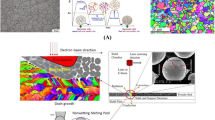Abstract
In high-pressure die casting (HPDC) undercuts can only be fabricated by using complex high-maintenance sliders. Until now, this technology has not been used for large-scale and cost-sensitive serial applications. Sand cores from sand-and low-pressure die casting with organic and inorganic binder systems are not suitable for application in HPDC. Using lost cores made from sodium chloride may be a solution for HPDC. Due to the high dynamic forces during the casting process, core failure is still a problem, especially with high ingate velocities.
In this work, the use of numerical simulation is investigated to predict core failure during the casting process. The numerical results are compared with corresponding experiments to evaluate the simulation results with mechanical characterization. This way, an objective, data-based approach to find process parameters for the successful use of lost salt cores in HPDC without costly, time consuming trial-and-error-testing was established.
Similar content being viewed by others
References
Anderko, K., Stark, M., “Kern für Gießereizwecke,” Gießerei, vol. 56, pp. 540–545 (1969).
Yamada, Y., Yaokawa, J., Yoshii, H., Anzai, K., “Developments and application of expendable salt core materials for high-pressure die casting to apply closed-deck type cylinder block,” JSAE-Report (Society of Automotive Engineers of Japan), pp. 1–5 (2007).
Graf, E., Izquierdo, P., Lingl, P., Ludwig, P., Schwarz, C., Söll, G., DE Patent No. 10, 2008, 013, 813 (Mar. 12, 2008).
Verran, G.Q., Mendes, R.P.K., Rossi, M.A., “Influence of injection parameters on defects formation in die casting al12si1,3cu alloy: Experimental results and numeric simulation,” J. Mater. Process. Technol., vol. 179, pp. 190–195 (2006).
Rosindale, I., Davey, K., “Steady state thermal model for the hot chamber injection system in the pressure die casting process,” J. Mater. Process. Technol., vol. 82, pp. 27–45 (1998).
Helenius, R., Lohne, O., Arnberg, L., Laukli, H., “The heat transfer during filling of a high-pressure die-casting shot sleeve,” Mater. Sci. Eng., A, vol. 413–414, pp. 52–55 (2005).
Ahuett-Garza, H., Miller, R.A., “The effects of heat released during fill on the deflections of die casting dies,” J. Mater. Process. Technol., vol. 142, pp. 648–658 (2009).
Lee, B., Baek, U., Han, J., “Optimization of Gating System Design for Die Casting of Thin Magnesium Alloy-Based Multi-Cavity LCD Housings,” J. Mater. Eng. Perform., pp. 1–11 (2012).
Hilbinger, M., Köpf, J., Rübner, M., Singer, R.F., “Computational optimization of plunger movement during slow shot phase in high-pressure die casting,” International Foundry Research, vol. 63, pp. 44–50 (2011).
Yarlagadda, P.K.D.V., Chiang, E.C.W., “A neural network system for the prediction of process parameters in pressure die casting,” J. Mater. Process. Technol., vol. 89–90, pp. 583–590 (1999).
Domkin, K., Hattel, J.H., Thorborg, J., “Modeling of high temperature- and diffusion-controlled die soldering in aluminium high-pressure die casting,” J. Mater. Sci. Process. Technol., vol. 209, pp. 4051–4061 (2009).
Hur, D.-S., Mizutani, N., Kim, D.-S., “Direct 3-D numerical simulation of wave forces on asymmetric structures,” Coastal Engineering, vol. 51, pp. 407–420 (2004).
Hojjat, M., Stavropoulou, E., Gallinger, T., Israel, U., Wüchner, R., Bletzinger, K.-U., “Fluid-Structure Interaction in the Context of Shape Optimization and Computational Wind Engineering,” in Bungartz, H.-J., Mehl, M., Schäfer, M., “Fluid Structure Interaction II,” (lecture notes in Computational Science and Engineering,) vol. 73, pp. 351–381, Springer Berlin Heidelberg (2010).
Takizawa, K., Moorman, C., Wright, S., Spielman, T., Tezduyar, T.E., “Fluid-structure interaction modeling and performance analysis of the Orion spacecraft parachutes,” Int. J. Numer. Methods Fluids, vol. 65, pp. 271–285 (2011).
Wang, C.M., Tay, Z.Y., “Hydroelastic Analysis and Response of Pontoon-Type Very Large Floating Structures” in: Bungartz, H.-J., Mehl, M., Schäfer, M., “Fluid Structure Interaction II,” (lecture notes in Computational Science and Engineering,) vol. 73, pp. 103–130, Springer Berlin Heidelberg (2010)
Grötzinger, D., DE Patent No. 10, 359, 547 (Mar. 3, 2005).
Roebben, G., Bollen, B., Brebels, A., Van Humbeeck, J., Van der Biest, O., “Impulse excitation apparatus to measure resonant frequencies, elastic moduli, and internal friction at room and high temperature,” Review of Scientific Instruments, vol. 68, pp. 4511–4515 (1997).
DIN EN 843-1: “Hochleistungskeramik-Mechanische Eigenschaften monolithischer Keramik bei Raumtemperatur-Teil 1: Bestimmung der Biegefestigkeit.”
Hirt, C.W., Nichols, B.D., “Volume of Fluid (VOF) Method for the Dynamics of Free Boundaries,” J. Comput. Phys., vol. 39, pp. 201–225 (1981).
Brethour, J.M., Isfahani, A.H.G., “The Fluid-Structure Interaction and Thermal Stress Evolution Models in FLOW-3D,” Flow Science, Inc., Santa Fe, NM USA 87505.
Lohkämper, T., “Phasenverschiebungs-Interferenzmikroskopie von lastinduzierten Lösungs/Fällungsprozessen an Grenzflächen von Halit und NaCl-Lösung,” Ruhr-Universität Bochum (2003).
Author information
Authors and Affiliations
Rights and permissions
About this article
Cite this article
Fuchs, B., Eibisch, H. & Körner, C. Core Viability Simulation for Salt Core Technology in High-Pressure Die Casting. Inter Metalcast 7, 39–45 (2013). https://doi.org/10.1007/BF03355557
Published:
Issue Date:
DOI: https://doi.org/10.1007/BF03355557




